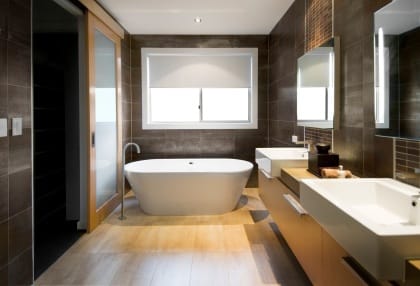Tiling design ideas
Planning the tiling design for your bathroom can be a real challenge. There are so many decisions to be made – think type, colour and size. We help breakdown what’s involved. Types The two main types of tiles are ceramic and porcelain. Ceramic tiles are usually cheaper than porcelain tiles, so great for the budget-conscious renovator, but are not […]

Planning the tiling design for your bathroom can be a real challenge. There are so many decisions to be made – think type, colour and size. We help break down what’s involved.
Types
The two main types of tiles are ceramic and porcelain. Ceramic tiles are usually cheaper than porcelain tiles, so they are great for budget-conscious renovators but are not as strong. Good-quality ceramic tiles can manage a moderate to heavy traffic flow, so they are still perfectly fine in a highly used area like the bathroom.
Porcelain tiles are generally more resistant to bathroom product spills as they won’t absorb oil. However, chemicals in bathroom staples like deodorant and hair spray can have an effect on the tile surface over time, so a regular wipe-over with a damp cloth is still required.
Porcelain tiles can be glazed or unglazed. Once glazed, porcelain tiling can feature patterns, varying colours, and stone look-alike finishes in matt or gloss. They can also be ground and polished to produce a completely flat surface and have a rectified finish, which means the tile edges are ground to an exact tile size with a square-edge finish.
Natural tiling, which includes slate, marble, granite and limestone, is also growing in popularity. Admired for its unique, one-of-a-kind look, natural tiling is more expensive than ceramic or porcelain tiling but, if cared for correctly, is just as durable and viewed as a great investment.
Colours
While there’s a kaleidoscope of different shades to select from, there’s really only one decision to be made when dealing with tiling colours…dark or light.
Dark colours can enclose a space but can be quite dramatic and contemporary in a larger space, while lighter tiles (especially on the walls) help create an illusion of space. If you do opt for more lightly toned tiles, be aware they’re more likely to show dirt marks and require more regular cleaning.
Sizes
Certain sizes of wall and floor tiles work best in different rooms. Large tiles (around the 600mm x 600mm mark) typically make a room look larger, while smaller mosaic tiles add a unique designer touch.
There are also other more practical elements to consider when selecting your tiling – such as non-slip rating. Some porcelain tiles even have small raised or bevelled-edge finishes to increase slip resistance.
With tiles available in a vast range of sizes, colours and materials, your tiling ideas are only limited by your own imagination.